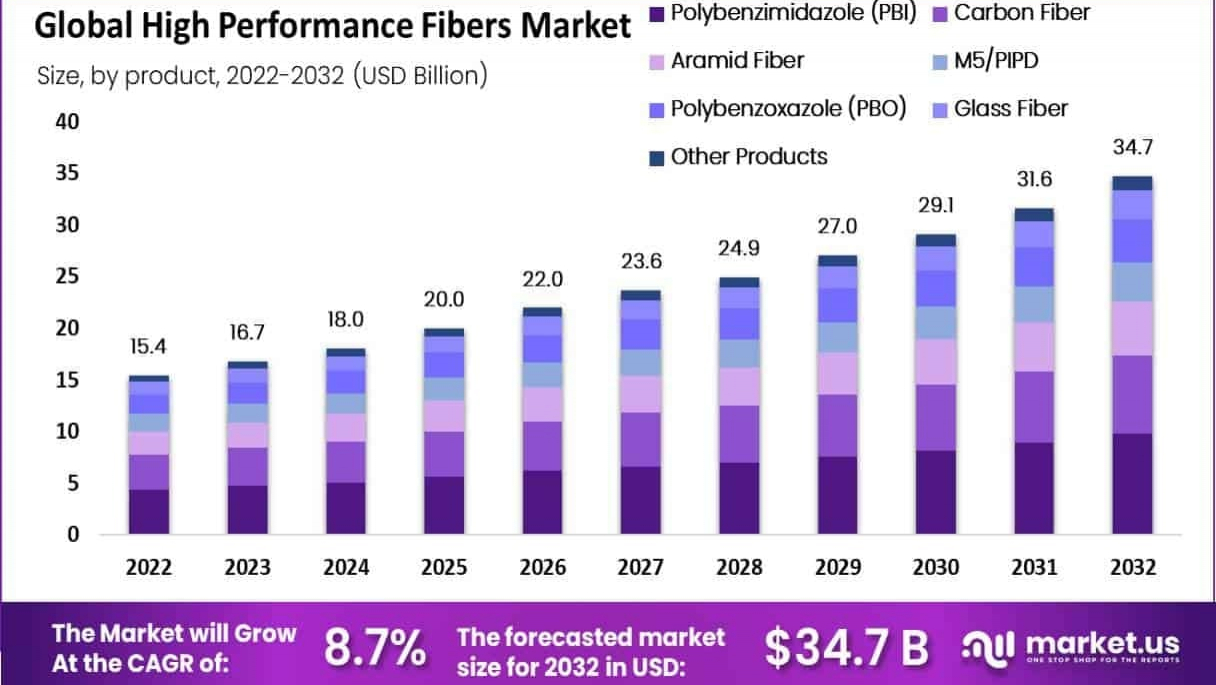Report Overview:
In 2022, the global high-performance fiber market was valued at USD 15.4 billion, with projections indicating it could rise to USD 34.7 billion by 2032, at a solid CAGR of 8.7%. These advanced fibers are essential in industries like aerospace, defense, electronics, and sporting goods, as they offer exceptional heat resistance, high strength-to-weight ratios, and durability. With growing substitution of conventional materials like metals and plastics, their importance continues to grow across industrial applications. High-performance fibers are specialized materials designed to withstand extreme conditions—such as high temperatures, stress, chemical exposure, or mechanical wear—without losing their strength, durability, or integrity.ommon types include carbon fiber, aramid fiber, polybenzoxazole (PBO), and polyimide fibers, which are known for their exceptional tensile strength, light weight, and resistance to heat and corrosion. Key Takeaways Current Market Size (2022): USD 15.4 billion Estimated Market Size (2032): USD 34.7 billion CAGR: 8.7% (2023–2032) Top-Selling Product: Polybenzimidazole (PBI) Leading Application Area: Aerospace & Defense (44% revenue share) Main End-Use Segment: Personal Use Regional Leader: Asia-Pacific (43.4% revenue share) Sample Report Request For More Trending Reports: https://market.us/report/high-performance-fiber-market/free-sample/
Key Market Segments
Based on Product Carbon Fiber Polybenzimidazole (PBI) Aramid Fiber M5/PIPD Polybenzoxazole (PBO) Glass Fiber High Strength Polyethylene Other Products Based on Application Electronics & Telecommunication Textile Aerospace & Defense Construction & Building Automotive Sporting Goods Other Applications Based on End-User Personal Public Other End-User DORT Analysis Drivers Rising demand for strong, lightweight materials Innovation in fiber production technologies Expansion in EV and aerospace sectors Opportunities Tailored fiber development and custom solutions Increasing consumption in developing economies Enhanced use in protective gear and high-stress environments Restraints Elevated manufacturing costs Raw material pricing volatility Presence of lower-cost alternatives Threats Difficulty in scaling up production Competitive pressure from advanced substitutes Growth Opportunity Integration of 3D printing and nanotech is lowering fiber production costs. Demand in electric vehicles is rising as these fibers reduce weight and boost performance. Rapid urban development in countries like India and China is supporting industrial fiber use. Latest Trends Advancements in carbon fiber tech enhance its appeal across more applications. Greater reliance on fiber composites for fuel-efficient aircraft. Expanding use of eco-conscious and smart textiles. Launch of innovative products like Twaron Black for high heat resistance. Market Key Players Toray Industries, Inc. Dupont Teijin Limited Toyobo Co. Ltd DSM Kermel S.A. Kolon Industries, Inc. Huvis Corp. I. du Pont de Nemours and Company Zoltek Companies Inc. Kamenny Vek Koninklijke Ten Cate NV Other Key Players
Conclusion:
The high-performance fiber market is poised for strong growth, with continued demand across aerospace, automotive, and defense sectors. Despite hurdles like high costs and alternative materials, ongoing innovation and regional expansion especially in Asia Pacific are driving positive momentum. Tailored product development and sustainable advancements will further solidify the industry's upward trajectory.









